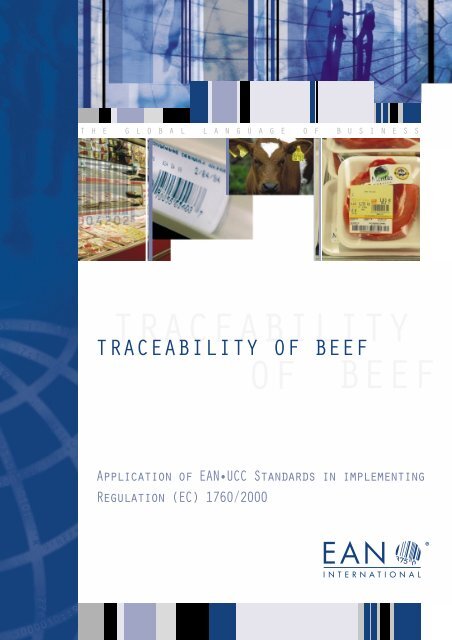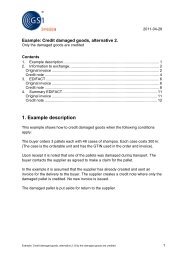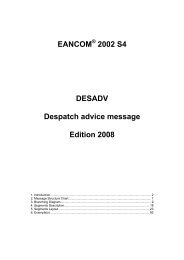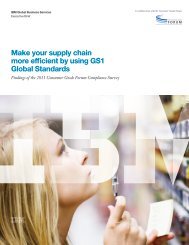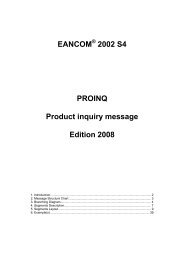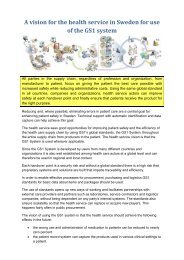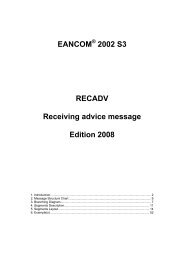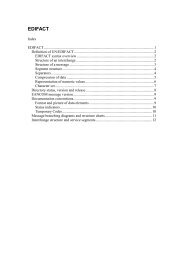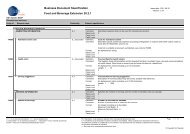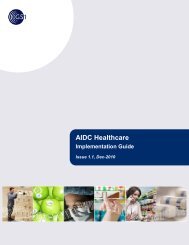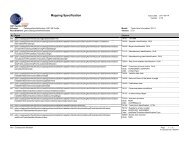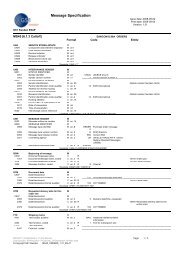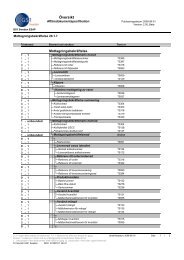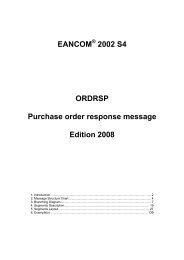TRACEABILITY OF BEEF - GS1
TRACEABILITY OF BEEF - GS1
TRACEABILITY OF BEEF - GS1
Create successful ePaper yourself
Turn your PDF publications into a flip-book with our unique Google optimized e-Paper software.
tabletable of contentsof contentsMANAGEMENT SUMMARY 2ACKNOWLEDGEMENTS 3INTRODUCTION 41 EAN•UCC AND EMEG 51.1 EAN International and UCC 51.2 EMEG 52 IMPACT <strong>OF</strong> REGULATION (EC) 1760/2000 73 EAN•UCC IDENTIFICATION SYSTEMS 83.1 Identifying bar codes 83.2 EAN•UCC bar codes with additional information 94 RECOMMENDATIONS 104.1 AI’s in the beef supply chain 114.2 Slaughtering 124.2.1 Regulation (EC) 1760/2000 124.2.2 EAN•UCC Recommendation 124.3 Cutting 134.3.1 Regulation (EC) 1760/2000 134.3.2 EAN•UCC Recommendation 144.4 Selling 144.4.1 Regulation (EC) 1760/2000 154.4.2 EAN•UCC Recommendation 155 GETTING STARTED 166 DEVELOPMENTS 176.1 Electronic Communication 176.2 Automatic Data Capture 17APPENDIX I : EXAMPLES <strong>OF</strong> LABELS 18Traceability of Beef 1>
MANAGEMENT SUMMARYThe repeal and replacement of Regulation (EC) 820/97 by Regulation (EC)1760/2000 (here called the ‘Beef Labelling Regulation’) has required furtherenhacement of the EAN•UCC System. The publication of the third edition‘Traceability of Beef Guidelines’ fully replaces the previously published first andsecond editions.The aim of these Guidelines is to provide a solution for the implementation ofthe Beef Labelling Regulation using an internationally accepted numbering andbar coding system – part of the EAN•UCC System. The use of commonidentification and communication standards significantly improves the accuracyand speed of information related to the origin and processing of beef, resultingin increased efficiency and cost reduction within the beef supply chain.Adoption of the ‘Traceability of Beef Guidelines’ is voluntary. These Guidelinesdefine the requirements needed to implement the Beef Labelling Regulation inorder to trace beef products. Furthermore, these Guidelines provide a current bestpractice model for the efficient implementation of the Beef Labelling Regulation.The use of EAN•UCC System in the beef supply chain is based upon the ‘GeneralEAN•UCC Specifications’. They are recommended by the United NationsEconomic Commission for Europe (UN/ECE) 2 .LIMITATIONS <strong>OF</strong> THE GUIDELINESThese Guidelines provide help, information and recommendations needed tounderstand and use the EAN•UCC System for traded units (packaged items) inthe beef supply chain between the slaughterhouse and the retail point-of-sale.Effective traceability from the slaughterhouse back to an individual animal orgroup of animals (which is required by the Beef Labelling Regulation) is basedupon the accuracy of the information about the animal held on the databasebelonging to the slaughterhouse. These Guidelines specifically address theEAN•UCC System of identification, numbering and bar coding for the purposeof tracking and tracing beef products. For standards relating to logistic items(pallets, cartons) please refer to the General EAN•UCC Specifications. Theimplementation of these Guidelines is recommended for those countries tradingbeef products with EU Member States, and refers to the application of Articles11, 12, 13, 14, and 15 of the Beef Labelling Regulation.These Guidelines do not address the use of EANCOM ® Messages, which will bedealt with in future releases of these Guidelines. For general information onTracking and Tracing, your national EAN Member Organisation should becontacted.The third edition of the ‘Traceability of Beef Guidelines’ may be amended at anytime, and republished as a new edition. These Guidelines are fully consistent withcommercial and inter-governmental arrangements for the identification of beefapplicable at the time of going to press.2 Please see the UN/ECE section on meat at http://www.unece.org/trade/agr2 >Traceability of Beef
ACKNOWLEDGEMENTSWe acknowledge the invaluable assistance given to EAN International in producingthese Guidelines by all organisations and individuals that participated in the workof the Meat Supply Chain Task Force, the United Nations Economic Commissionfor Europe Specialised Section on Meat Standardisation, the Meat AutomationConcerted Action Project, the Expert Advisory Board, and all members of theEMEG.EAN International would like to thank in particular the following organisationsfor their support:AECOC (EAN Spain)AUS-MEATCCG Centrale für Coorganisation GmbH (EAN Germany)Central Bureau of Provision Trade (NL: CBL)EAN ArgentinaEAN AustraliaEAN AustriaEAN BrazilEAN DenmarkEAN IrelandEAN NetherlandsEAN New ZealandEAN NorwayEAN Swedene.centre (EAN UK)European Commission DG AgriEuropean Livestock and Meat Trading UnionEuroCommerceEuroHandelsinstituteFrench Ministry of Economy (FR: DGCCRF)Gencod (EAN France)ICODIF (EAN Belgium and Luxembourg)INDICOD (EAN Italy)International Meat SecretariatLiaison Centre for the Meat Processing in the EUMeat Automation Concerted ActionMeat and Livestock AustraliaMeat and Livestock Commission (UK)Product Boards for Livestock, Meat and Eggs (NL: PVE)United Nations Economic Commission for EuropeUnited States Department of AgricultureOur special appreciation goes to all the companies, organisations, expert resourcesand technology suppliers that participated in the successful implementation ofthe EAN•UCC System in beef traceability pilot projects in Germany and Australia.Traceability of Beef 3>
INTRODUCTIONFood safety has become a critical priority for the meat supply chain. However,rather than just identifying a more generalised commodity group, an effective andcost-efficient traceability system should accurately pinpoint any problem in foodsafety related to a specific geographical origin, slaughtering or processing facility,down to a farm or even to the single animal.The European Commission has recognised an urgent need to regain consumerconfidence in beef products and therefore believes in fast tracing of beef productsthroughout the supply chain. Consequently on the basis of a proposal from theEuropean Commission, the European Parliament and Council have adapted aregulation on compulsory labelling of beef (EC) 1760/2000 (here called the BeefLabelling Regulation) 3 . This Regulation became effective in all EU Member Statesfrom January 2001.The Beef Labelling Regulation aims to ensure a link between, on one hand, theidentification of the carcass, quarter or pieces of beef and on the other hand, theindividual animal or the group of animals from which they are derived. In particular,the beef label must contain the following 6 mandatory elements in human readableformat:- A reference number or reference code ensuring the link between the meatand the animal or a group of animals;- Country of birth; 4- Country/countries of fattening; 4- Country of slaughter;- Country/countries of cutting;- Approval number of the slaughterhouse and cutting hall(s).Adopting the EAN•UCC System, a unique identification numbering systemtogether with the use of UCC/EAN-128 bar codes can help users to comply withthe Beef Labelling Regulation. These Guidelines show how to implement thisRegulation in an efficient manner using the EAN•UCC System. However, in thisedition, the Guidelines do not contain Electronic Data Interchange (EDI) 5solutions for Tracking and Tracing. EDI messages will be included in future releasesof these Guidelines.Chapter 1 gives a short description of the organisation behind the EAN•UCCSystem followed by an impact analysis of the Beef Labelling Regulation on thebeef supply chain in chapter 2. The third chapter provides an explanation of thebar codes used. The main part of this document, chapter 4 onwards examines stepby step the implications of implementation of these Guidelines for the meat supplychain.These Guidelines contain links to other documents relating to the generalimplementation of the Beef Labelling Regulation and the EAN•UCC System.Trading partners in the beef supply chain are advised to contact the relevantnational authority of the Member State in which they wish to trade to establishany differences in national implementation or interpretation of the legislation.EMEG will aim also to highlight such differences by publishing a document fromtime to time to accompany these Guidelines, on the web site of EAN Internationalat http://www.ean-int.org3 A copy of Regulation (EC) 1760/2000 can be found by visiting the European Union’s official web site at http://www.europe.eu.int4 Compulsory as of 1 January 2002; see Regulation (EC) 1760/2000 Article 13 (5a)5 EANCOM®is the EAN•UCC standard for EDI messages4 >Traceability of Beef
1 EAN•UCC AND EMEG1.1 EAN INTERNATIONAL AND UCCEAN International and the Uniform Code Council Inc. (UCC) are global,independent, not for profit organisations that jointly administer and maintain theEAN•UCC System. In the context of these Guidelines, reference will be mademainly to two complementary sets of EAN•UCC standards for effective supplychain management: the EAN•UCC standards for Automatic Identification andData Capture (AIDC), described in the General EAN•UCC Specifications, andthe EANCOM ® standard for Electronic Data Interchange (EDI). Currently EANInternational is developing EDI messages for the beef supply chain.The fundamental principle of the EAN•UCC System is an unambiguous numberingsystem used to identify goods or services throughout any supply chain. Usingautomatic data capture techniques, this numbering system can be applied successfullyat every stage of production or transformation and distribution. Whilst theimmediate and most visible application of the EAN•UCC System is a bar code(UPC or EAN-13 symbol), it is important to remember that a bar code is just amachine-readable representation of its associated number. The use of the EAN•UCCSystem ensures the uniqueness of the associated number that identifies the itemto which it is assigned.The EAN•UCC System works towards global uniqueness and overcomes problemsin confusion, duplications and misinterpretation, because all users of the EAN•UCCSystem follow the same coding rules. The EAN Member Organisations and UCClocally ensure the uniqueness of the numbers worldwide via the use of specificagreed prefixes. An EAN•UCC number can be recognised by trading partnersoperating locally or globally. Furthermore, the EAN•UCC System allows an itemto carry additional information, rather than just a unique identifying number, forexample, a company or industry specific reference number or a batch number.EAN is represented in 98 countries in the world. With its Head Office based inBrussels, EAN International co-ordinates all its 96 EAN Member Organisations,and provides written guidelines on the use of the EAN•UCC System 6 . EANInternational is partner to the Uniform Code Council (UCC) in the USA andCanada to ensure worldwide consistency of the EAN•UCC System.1.2 EMEGIn late 2000, EMEG (European Meat Expert Group) was established within EANInternational to examine the implications of the new Beef Labelling Regulationand to set down agreement amongst EAN’s European Member Organisations todetermine how the EAN•UCC System could be applied to serve the meat supplychain.EMEG has met regularly to formulate the ‘Traceability of Beef Guidelines’.Because these Guidelines are focused on the Beef Labelling Regulation, they areprimarily intended for:6 For further information, please visit http://www.ean-int.org or the website of your local Member Organisation.Traceability of Beef 5>
- All EU Member States;- Non-EU countries exporting to EU Member States;- Countries that are non-EU Member States but which have decided to adoptthe Beef Labelling Regulation as the primary means for Tracking and Tracingin the meat supply chain.(See figure 1 for all EU Member States)Goals of the EMEG:- To provide the European market with an uniform solution to implement theEC Regulation (EC) 1760/2000 with the EAN•UCC System- To exchange knowledge and experiences concerning the use of theEAN•UCC System in the meat supply chainEU Member CountriesFigure 1: European Union (EU) Member StatesNote:Although not an EU Member State, the Norwegian government has decided to make the BeefLabelling Regulation mandatory in Norway.For an overview of national appendixes as part of these Guidelines, please visit the EAN Internationalwebsite at http://www.ean-int.org6 >Traceability of Beef
2 IMPACT <strong>OF</strong> REGULATION (EC) 1760/2000Traceability of beef requires a verifiable method to identify bovine animals, carcassesand cuts in all their packaging and transport/storage configurations at any pointin the supply chain. Unique identification numbers must be applied and recordedaccurately to guarantee a link between each point of processing in the supplychain.The system of identification and registration of bovine animals in the EuropeanUnion is comprised of the following elements 7 :- Ear-tags to identify animals individually;- Computerised databases;- Animal passports;- Individual registers kept on each (farm) holding;The data documenting an animal's history must be included in its passport or ina database.Tracking and Tracing of beef has generated asignificant amount of interest and debate. Itis important to distinguish between the legalrequirements, necessary technologies requiredto implement Tracking and Tracing, and theEAN•UCC System.Legislators establish the legal requirements regarding food safety. The EAN•UCCSystem enables efficient food safety management. However, it is the responsibilityof the trading partners in a supply chain to take advantage of the capabilities thatthe EAN•UCC System provides, to ensure full compliance with Regulation (EC)1760/2000 (here called the “Beef Labelling Regulation”). Recently, the UnitedNations decided to recommend use, officially, of the EAN•UCC System forTracking and Tracing of beef 8 . The European beef supply chain intends toimplement the Beef Labelling Regulation with the help of the EAN•UCC System.‘Tracking’ is the retrieval of the actual status of a shipment, a package etc.Tracking is the ability to follow the path of a specified unit and/or batch of a productdownstream through the supply chain as it moves between trading partners. Productsare tracked routinely for availability, inventory management and logistical purposes. Inthe context of these Guidelines, the focus is on tracking of beef products from theslaughterhouse to retail point of sale.‘Tracing’ is the retrieval of information to reconstruct the history of a shipment, package etcTracing is the ability to identify the origin of a particular unit and/or batch of productlocated within the supply chain by reference to records held by trading partners upstreamin the supply chain. Products are traced for purposes such as product recall and forthe investigation of complaints.In the context of these Guidelines, the focus is on tracing of beef products from retailpoint of sale back to the slaughterhouse. These Guidelines do not trace the movementof live animals between (farm) holdings. Traceability back to the individual animal,including verification of the animal’s countries of birth and fattening is dependent uponthe accuracy of information that is required by the Beef Labelling Regulation.The datais held by the slaughterhouse.7 Regulation (EC) 1760/2000: article 38 Please see the UN/ECE section on meat at http://www.unece.org/trade/agrTraceability of Beef 7>
3 EAN•UCC IDENTIFICATION SYSTEMSBar codes carry data. The bar code is used in the EAN•UCC System to encoderelevant data about the product or service for each stage in the supply chain. Insimple terms, a bar code consists of a series of vertical parallel and adjacent (darkcoloured)bars and (light-coloured) spaces. Predetermined width patterns for barsand spaces are used to encode and represent actual data in the bar code. This datacan be the Global Trade Item Number (GTIN) itself or any additional informationattributed to the item. A bar code reader (scanner) decodes the width patterns ofthe bars and spaces. The combination of bar code labels and scanners allows realtimedata capture.3.1 IDENTIFYING BAR CODESGenerally speaking, each traded product (for example, a meat package intendedfor retail point of sale) or an aggregate of tradable products (for example, a crateof different meat packages transferred from the storage location to the retail outlet)is allocated a global unique EAN•UCC number. This is known as the GlobalTrade Item Number (GTIN). The GTIN contains no information at all aboutthe product; it is just a worldwide unique and unambiguous identification number.The GTIN can be encoded into a bar code. The well-known EAN-13 bar code,which is often used for scanning at retail point of sale, is given in Figure 2 forillustration purposes.87 1234567 = Company Prefix001 = Item Reference6 = Check DigitNote: In this example 9 digits are used for the Company Prefix. In cases where 7 or 8 numbers digitsare used for the Company Prefix (according to the assignment rules of each EAN MemberOrganisation) the Item Reference will be respectively 5 or 4 digits long.- An EAN Member Organisation assigns the EAN•UCC Company Prefix toan EAN•UCC System user. It assures that the number is unique worldwide.- The EAN•UCC System user, who is also the ultimate product owner assignsthe Item Reference. Each different trade item is given a unique Item Reference.- The Check Digit is the result of a known calculation of the figures in thepreceding positions. Its use is for error detection and its verification is carriedout automatically by the bar code reader to ensure that the number is correctlycomposed.Figure 2: Numeric Construction of the EAN-13 bar code8 >Traceability of Beef
3.2 EAN•UCC BAR CODES WITH ADDITIONAL INFORMATIONAs noted above, the GTIN does not contain any specific information about theproduct, it is simply an identification number that can be used as a key to accessinformation, stored into an organisation’s database. However, additional productinformation may also be required, for example the product’s batch number, weight,or use by date. Within the meat supply chain the UCC/EAN-128 bar codesymbology may be used to encode data additional to the product identification(GTIN). Examples of these could be, ‘slaughter date’, ‘ear-tag number’ and ‘approvalnumber of the slaughterhouse’. The EAN•UCC Application Identifiers (AI’s) aremandatory when using the UCC/EAN-128 symbology and they define thestructure of the data encoded in the following Data Element:Figure 3 shows an example of a UCC/EAN-128 bar code applied to a piece ofbeef at the slaughterhouse:(01)98712345670019 = GTIN(3102)003725 = Net Weight1243857 = Reference Number- The AI (01) indicates that the following Data Element (98712345670019) isthe GTIN.- The slaughterhouse uses a specific GTIN for that specific piece of meat:98712345670019- At the beginning of the Data Element there is a 9, which indicates that aproduct has variable quantity (in this case weight).- AI (3102) indicates the Net Weight of the product, in this example,37.25 kilograms.- AI (251) indicates the Reference Number of the original animal, in this exampleNL21243857Figure 3: Use of UCC/EAN-128 bar code on beef product at slaughterhouseEAN International, in conjunction with the UCC, predefines the meaning of anyAI. For Tracking and Tracing of beef, EAN International has introduced new AI’s,that can be used in the traceability of other food product.Traceability of Beef 9>
4 RECOMMENDATIONSThis chapter will examine each step of the beef supply chain and explain how theEAN•UCC System is implemented in accordance with the Regulation. It willidentify also any specific national interpretations of this legislation. All participantsin the supply chain should take individual responsibility for providing the barcode with the right information, and must ensure that secure, accurate recordingsystems for that information are maintained.The information contained in this chapter is based upon the figure below, anoverview of information exchange in Beef Labelling (EC) 1760/2000 using theEAN•UCC System.Information exchange in Beef Labelling a)SLAUGHTERING CUTTING SELLING CONSUMINGCarcass ticket Processing label Consumer labelEAN•UCCSYMBOL:EAN•UCCSYMBOL:EAN•UCCSYMBOL:EAN•UCCSYMBOL:NONE EAN/UCC 128 EAN/UCC 128 EAN-13EANCOM ® (EDI), EAN/UCC 128:Valid passport orEar-tag number b)health certificateAI 01 GTINAI 251 Ear-tag no. b)figure 5Additional AI’s in EAN/UCC 128(without EANCOM ® ):AI 422 Country of birthAI 423 Countries of fatteningAI 7030 Country of slaughterand approval no. ofthe slaughterhouseEANCOM ® (EDI), EAN/UCC 128:AI 01 GTINAI 251 Ear-tag no. b)ORAI 10 Batch no.figure 6+7Additional AI’s in EAN/UCC 128(without EANCOM ® ):AI 422 Country of birthAI 423 Countries of fatteningAI 7030 Country of slaughterand approval no. ofslaughterhouseAI 7031-39 Countries of cuttinghalls and approval no.of cutting hallsOnly a GTIN which is the key tothe article database during scanningat the point of sale.figure 8a) with respect to Regulation (EC) 1760/2000b) EAN International recommends the ear-tag number as a reference number, France is using the slaughter code for the national marketFigure 4: Overview of information exchange Beef Labelling (EC) 1760/2000It should be noted that national governments and companies could requireadditional business bar coded information to appear on their labels. Any suchvoluntary information should be submitted for approval to the competent authorityof the Member State involved, in accordance with procedure foreseen in article16 of Regulation (EC) 1760/2000. We advise users to check with their competentnational authority the legal status of any additional information they may wishto provide. In the UK, for example, 'best before' or 'use by' dates do not needapproval, whilst ‘method of slaughter’, for example by Halal or Kosher methodsdoes.See also the UK appendix and other national appendices at http://www.ean-int.org10 >Traceability of Beef
4.1 AI’S IN THE <strong>BEEF</strong> SUPPLY CHAINIn this chapter you will find the AI’s recommended by EAN International inimplementing Regulation (EC) 1760/2000 9 .AI Full Title Data Title Format AI Format Use of the AI in the Beefdata field Supply Chain01 Global Trade GTIN N2 n14 EAN•UCC Global Trade ItemItem NumberNumber10 Batch/Lot BATCH/LOT N2 an..20 Batch numbernumber251 Reference of REFERENCE N3 an..30 Ear-tag number 10Source entity TO SOURCEENTITY422 Country of ORIGIN 11 N3 n3 Country of birth expressed byorigin ISO 3166 12423 Country of COUNTRY- N3 n..15 Possibility for 5 ISO countryinitialINITIAL codes for identifying aprocess PROCESS maximum of 5 countries offattening426 Country of COUNTRY- N3 n3 All preceding steps in theProcessing FULL supply chain have taken placePROCESSwithin the same country7030 Approval PROCESSOR # N4 n3+ ISO country code plus theup to Number of an..27 approval numbers of a7039 Processor maximum 10 succeedingprocessors in the chain. 7030is always to be used for theslaughterhouse. 7031 until7039 for the cutting halls.nxn..xan..x: numeric (n) field with fixed length as indicated (x).: numeric (n) field with variable length. Maximum length as indicated (x): alpha numeric (an) field with variable length. Maximum length as indicated (x)Table 1: AIs recommended by EAN International in implementing Regulation (EC) 1760/2000Extra information concerning AI 423 and AI 7030-7039:n..15 : 5 times 3 numbers to fill in the ISO country codean..27 : to fill in the approval numbers9A full list of Application Identifiers is available in the General EAN•UCC Specifications at http://www.ean-int.org10 Or another reference code that relates to the animal of which the cut meat is derived11 ‘Origin’ here does not have the same meaning as stated in the Regulation. Here it means only country of birth!12 Refer to www.iso.ch for current list of ISO country codes.Traceability of Beef 11>
4.2 SLAUGHTERINGThe slaughterhouse is the first stage in the beef supply chain which uses theEAN•UCC System. Traceability back to the individual animal relies on the accuracyof information that is required by the Beef Labelling Regulation and held by theslaughterhouse.4.2.1 REGULATION (EC) 1760/2000The living animals are required to have the following papers when they arrive atthe slaughterhouse:- Either, an accompanying document (animal passport) or a certificate of goodhealth, and- Ear-tags within a lawful reference number to identify the animals individually.The Slaughterhouse must record and make accessible the following information:Regulation (EU) 1760/2000 RequirementArticle number- A reference number or reference code ensuring the link 13 (2a)between the meat and the animal or a group of animals 13- Approval number of the slaughterhouse 13 (2b)- Country of birth 13 (5a.-i)- Country / countries of fattening 13 (5a.-ii)- Country of slaughter 13 (5a.-iii)The Beef Labelling Regulation states that “the compulsory labelling system shallensure a link between, on one hand, the identification of the carcass, quarter orpieces of meat and, on the other hand, the individual animal or, where this issufficient to enable the accuracy of the information on the label to be checked,the group of animals concerned” 14 .It is important to note that if animals are born, raised and slaughtered in the samecountry, then the information can be combined on the label to read 'Origin' 15 .4.2.2 EAN•UCC RECOMMENDATIONThe carcass must be identified with a reference numbers EAN Internationalrecommends the ear-tag number to identify the carcass.UCC/EAN-128 bar code symbol on the carcass ticketThe data shown in the table below can be encoded in the UCC/EAN-128 bar code:DataUCC/EAN-128- Country of birth; AI 422AI 426*- Country/countries of fattening; AI 423- Country of slaughter and approval number of AI 7030the slaughterhouse;- Ear-tag number; AI 251- EAN•UCC Global Trade Item Number. AI 0113 EAN International recommends the use of the ear-tag number14 Text taken from Regulation (EC) 1760/2000: article 13.115 Text taken from Regulation (EC) 1760/2000: article 13 (5b)}12 >Traceability of Beef
When EANCOM ® (EDI) messages are used, only two out of the five AIs listedabove are needed on the label; AI 251 (Ear-tag number) and AI 01 (GTIN of theproduct). It should be noted that all the AIs listed above are maintained inEANCOM ® messages when they are used.Note:- * Where the countries of birth, fattening and slaughtering are the same, AI 426 (Country offull processing) can be used, instead of AI 422 (country of birth) and AI 423 (country/countriesof fattening). The AI 7030 is still needed for encoding the approval number of the slaughterhouse.- The EANCOM ® (EDI) messages are in the process of development, and therefore a full solutionwill be provided for in future releases of these Guidelines.Example: Appendix ‘Examples of Labels’; figure 5, page 184.3 CUTTINGThe slaughterhouse should forward all relevant information about the animal andthe carcass to the first cutting hall in accordance with regulatory and businessrequirements. The cutting hall is understood to cover all meat processing, fromthe carcass-half, through cutting, to the retail package.Using the EAN•UCC System itis possible to encode a maximumof nine cutting halls in the supplychain. Each cutting hall shouldforward all relevant informationabout the animal and carcass tothe next cutting hall in the supplychain in human readable text inaccordance with regulatory andbusiness requirements.4.3.1 REGULATION (EC) 1760/2000Each cutting hall must record and make accessible the following informationduring the cutting process to meet the requirements of the Beef Labelling Regulation.Regulation (EC) 1760/2000 RequirementArticle number- A reference number or reference code ensuring the link 13 (2a)between the meat and the animal or a group of animals 16- Approval number of the slaughterhouse 13 (2b)- Approval number(s) of the cutting hall (s) 13 (2c)- Country of birth 13 (5a.-i)- Country / countries of fattening 13 (5a.-ii)- Country of slaughter 13 (2b)- Country / countries of cutting 13 (2c)16 EAN International recommends the use of the ear-tag numberTraceability of Beef 13>
4.3.2 EAN.UCC RECOMMENDATIONAny batch made up by the cutting hall may comprise at most one day’s productionin the processing plant, and must only contain beef slaughtered in the sameslaughterhouse (and if relevant, processed in the same plant). Often only informationrelating to the entire batch might be written on the cutting hall label. Everyindividual piece of meat or package of chopped meat must have a label.UCC/EAN-128 bar code symbol on the processing labelThe data shown in the table below can be recorded in the UCC/EAN-128 BarCode:DataUCC/EAN-128- Country of birth; AI 422- Country/countries of fattening; AI 423- Country of slaughter and approval number of AI7030the slaughterhouse;- Country and approval number of the 1 st cutting hall; AI 7031- Country and approval number of 2 nd cutting hall; AI 7032- Country and approval number of the 3 rd cutting hall..- AI 7033-39..until the 9 th cutting hall;- Either ear-tag number for individual cutting, or AI 251 orbatch number of cutting group AI 10- EAN•UCC Global Trade Item Number AI 01}AI 426*When EANCOM ® (EDI) messages are used, only two of the AIs listed above areneeded on the label; either AI 251 (Ear-tag number) or AI 10 (batch number ofthe cutting group), and AI 01 (GTIN of the product). It should be noted that allthe AIs listed above are maintained in EANCOM ® messages when they are used.Note:- * The Application Identifier (426) indicates that the data field contains the ISO country codeof the country where all the processing of the trade item took place. If this AI is used, the fullprocessing of a trade item must have taken place in a single country. This is particularly importantin certain applications, such as livestock (where it would cover things such as the animal's birth,fattening, and slaughter), where processing could take place in different countries. In situationslike this, AI (426) may not be used. It is the responsibility of the supplier to allocate the correctcountry code. The AI 7030 – 7039 are still needed for encoding the approval number of theslaughterhouse and the cuttinghall(s)..Example: Appendix ‘Examples of Labels’; figure 6, page 18 and figure 7, page 194.4 SELLINGThe final cutting hall or processor should forward all relevant information aboutthe animal, carcass and previous processes to the next process in the supply chainin accordance with all regulatory and business requirements. This could be to awholesaler, cold storage warehouse, or directly to a retail outlet.It is important to make the distinction in these Guidelines between beef products14 >Traceability of Beef
sold ‘pre-packed’ and ‘non pre-packed’ at the retail point of sale. These Guidelinesonly address how pre-packed beef products should be labelled in accordance withthe Beef Labelling Regulation and the EAN•UCC System at the retail point ofsale. The Guidelines do not address howinformation about non-prepacked beef productsshould be provided to consumers since EUMember States have set down different nationalimplementation requirements concerning theinformation flow of unpacked beef behind thecounter.4.4.1 REGULATION (EC) 1760/2000At the retail point of sale, the final consumer must be informed of the origin ofthe beef as the European Commission has established that the information on aconsumer label on a packaged beef product must be in human readable formator provided in another way in case it concerns unpacked beef. The consumer labelmust therefore contain the following information, in human readable format:Regulation (EC) 1760/2000 RequirementArticle number- A reference number or reference code ensuring the link 13 (2a)between the meat and the animal or a group of animals; 17- Approval number of the slaughterhouse; 13 (2b)- Approval number(s) of the cutting hall; (s) 13 (2c)- Country of birth; 13 (5a.-i)- Country / countries of fattening; 13 (5a.-ii)- Country of slaughter; 13 (2b)- Country / countries of cutting; 13 (2c)4.4.2 EAN•UCC RECOMMENDATIONA trader should contact the competent national authority to establish the (consumer)beef labelling requirements for non pre-packed beef at the retail point of sale.The information bar coded as a UCC/EAN-128 bar code onto the ProcessingLabel can be used to generate the final consumer label.Similarly to any other retail consumer product, a GTIN shall be present on thefinal trade unit, intended for automatic scanning at the retail point of sale checkoutsystem.Example: Appendix ‘Examples of Labels’; figure 8, page 19You can find national supplements on the regulation (EC) 1760/2000 at the EANInternational website http://www.ean-int.org17 EAN International recommends the use of the ear-tag numberTraceability of Beef 15>
5 GETTING STARTEDThe first step to introduce the EAN•UCC System in your company in order tofulfil the compulsory Beef Labelling Regulation, is to be able to construct and useyour own GTINs.To construct a GTIN, an EAN•UCC Company Prefix is always needed. In orderto obtain an EAN•UCC Company Prefix, please contact your national EANMember Organisation and register as a member.The national EAN Member Organisation is completely at your disposal. For anyquestions related to the introduction of the EAN•UCC System and/or related tothe Traceability of Beef Guidelines or meat supply chain, the national EANMember Organisation will be pleased to assist you.Addresses and telephone numbers of all national EAN Member Organisation canbe found at the website of EAN International http://www.ean-int.org16 >Traceability of Beef
6 DEVELOPMENTSThe EAN•UCC System is used globally throughout a large number of industries.As technology evolves, the EAN•UCC System is updated accordingly. This chapterexplains how the existing EAN•UCC System is being applied in the context ofthe traceability of beef products. It also considers how new technologies representopportunities to improve current best practice.6.1 ELECTRONIC COMMUNICATIONBesides using bar codes to exchange on data between trading partners, ElectronicData Interchange (EDI) is also used. EDI offers a more efficient and reliable wayof communicating large amounts of data through the supply chain. EANCOM ®is the EAN•UCC standard for EDI , and is applied to UN/EDIFACT messages.This standard is widely used by more than 50,000 users worldwide. EAN willdevelop user guidelines for the use of EANCOM ® messages in the traceability ofbeef products in the near future.Furthermore, in August 2001 EAN and UCC published version 1.0 of the GlobalVoluntary Standards for the Exchange of Electronic Business Standards using‘eXtensible Markup Language’ (XML). The EAN•UCC XML standards are nowan integral part of the EAN•UCC System. The relevant Business Message Standardsand XML Schemas can be downloaded from the EAN International website,http://www.ean-int.org, or via your national EAN Member Organisation.6.2 AUTOMATIC DATA CAPTUREThese Guidelines describe how UCC/EAN-128 bar codes can be applied toimplement the Beef Labelling Regulation. EAN•UCC is developing on newautomatic data capture technologies. The EAN•UCC Reduced Space Symbology(RSS) and Composite Symbologies offer enhanced possibilities to print moreinformation on barcodes of smaller dimensions. The introduction of EAN•UCCRSS and Composite Symbologies is scheduled for early January 2002. The firstGuidelines are being developed also in the context of Variable Measure Itemapplications.EAN•UCC is also a leading organisation in the standardisation of RadioFrequency Identification technology (RFID). It is working closely with the ISO 18standard body, the national administrations in charge of radio spectrum regulation,with CEPT (European Conference of Post and Telecommunications) and ETSI(European Telecommunications Standardisation Institute). In addition, theEAN•UCC GTAG Project is finalising the technology specifications and settingup ‘proof of concept’ pilot projects to test and evaluate RFID technology forlogistic supply chain applications.18 International Organization for StandardizationTraceability of Beef 17>
APPENDIX I: EXAMPLES <strong>OF</strong> LABELSThe labels below are examples, the form, size and human readable contents of thelabels can deviate from country to country. Only the recommended AIs are includedin the bar code, every country is free to encode additional AI’s in the bar code andcomply with additional regulations where required.For national specifications, please contact your national EAN Member Organisation.CARCASS TICKETViande Belgique S.A.CARCASS Young bull R round 3-Weight: 523,8 KgArticle Number GTIN: 5487722000252 Ref to source: DK09999902002Born in: Denmark Fattened in: Germany, AustriaSlaughtered in: Belgium Approval number slaughterhouse: UD1098HFigure 5: Carcass Ticket.Note: bar codes symbols are for illustration only and not printed to scale.FIRST PROCESSING LABELHolland Vlees B.V.HIND QUARTER WITH FLANK 5 ribs, U qualityWeight: 237,6 KgArticle Number GTIN: 8712345000967 Ref to source: DK09999902002Born in: Denmark Fattened in: Germany, AustriaSlaughtered in: Belgium Approval number slaughterhouse: UD1098HCutted in: Netherlands Approval number cutting hall: 9638Figure 6: Processing Label (1st cutting hall).Note: bar codes symbols are for illustration only and not printed to scale.18 >Traceability of Beef
SECOND PROCESSING LABELEl Torro S.L.STRIP LOIN bone-inn 5 ribsWeight: 12,9 KgArticle Number GTIN: 8499910000996 Ref to source: 01070110Born in: Denmark Fattened in: Germany, AustriaSlaughtered in: Belgium Approval number slaughterhouse: UD1098HCutted in: Netherlands Approval number cutting hall: 9638Cutted in: Spain Approval number cutting hall: 6373MFigure 7: Processing Label (2nd cutting hall).Note: bar codes symbols are for illustration only and not printed to scale.CONSUMER LABELFlanksteak PADReference number: 02070105Born in: Denmark Fattened in: Germany, AustriaSlaughtered in: Belgium Approval number slaughterhouse:UD1098HCutted in: Netherlands Approval number cutting hall: 9638Cutted in: Spain Approval number cutting hall: 6373MEl ButcherBest Before:19.09.2001Packed:16.09.200116,79 0,250Price Euro/Kg Weight /Kg 4,20Price/EuroFigure 8: Consumer labelTraceability of Beef 19>
EAN InternationalEAN International and the Uniform Code Council Inc. (UCC), its partner in theUSA and Canada, are driving forward their vision of ‘one system for the globalmarketplace’ through leadership, innovation, technology support and theestablishment of multi-industry standards for product identification and relatedelectronic communications.Through a comprehensive set of products and logistic identification tools, standardbar codes and electronic commerce activities, EAN and UCC provide any tradingpartner with the means to effectively implement global supply chain management.Edited byPublication historyCopyrightDisclaimerTrademarkCirculationAny questionsAddressEuropean Meat Expert Group, EMEGTraceability of Beef – Second updated edition, November 2000(The repealing by Regulation (EC)1760/2000)Traceability of Beef – First updated edition, February 1999(Regulation (EC) 820/97)© EAN International, 2002. All third parties rights acknowledged.The text of this brochure can be copied or processed without permission, subjectto the acknowledgement of all sources quoted. Only European Communitylegislation as printed in the Official Journal of the European Communities isdeemed to be authentic.While every possible effort has been made to ensure that the information in theseGuidelines is correct, EAN International disclaims liability for any mistakes oromissions in these Guidelines.EANCOM ® is a registered trademark of EAN International. It is applied to theEAN•UCC System of UN/EDIFACT (EDI) messages.These Guidelines are written on behalf of all organisations within the beef supplychain in Europe, who are required to implement Regulation (EC) 1 1760/2000.These Guidelines are available to any interested party, upon request, from thenational EAN Member Organisation.If you have any questions or comments about this publication or about the workof EAN International in general (including the use of the EAN•UCC System),please do not hesitate to contact your national EAN Member OrganisationEAN International145 rue Royale1000 BrusselsBelgiumTel. +32 2 227 10 20Fax +32 2 227 10 21E-mail: info@ean-int.orgWeb site: www.ean-int.org1 European CommissionEANINTERNATIONAL®20 >Traceability of Beef
For detailed information on the EAN products and services, or the contactdetails of the UCC or the EAN Member Organisations around the world,have a look at the official EAN International website:www.ean-int.orgThe Global Languageof BusinessEANINTERNATIONAL®EAN InternationalRue Royale 145 - 1000 Brussels, BelgiumTel: +32 (0)2 227 10 20 - Fax: +32 (0)2 227 10 21E-mail: info@ean-int.org5 425000 034094


